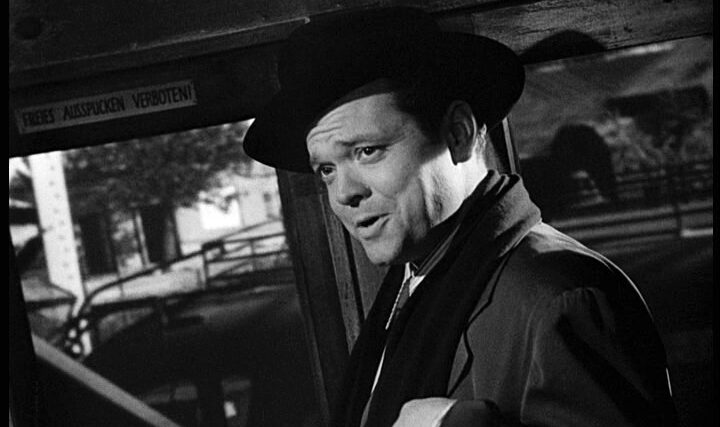One of the greatest movies of a generation was the result of a few serendipitous circumstances.

Credit: Insomnia Cured Here
As a thirteen-year-old in 1949, I went to the movies every week—my local movie house was just three blocks from my home and a ticket cost fifteen cents. My favorite films were typical of a teenager: Abbott and Costello comedies, westerns, and gangster films. But, as a budding cinephile, one film resonated with me as no other: The Third Man. The day I saw it I sat through two showings, I was so taken by the story and the acting.
This year marks the 75th anniversary of The Third Man, a film that is regarded as England’s greatest cinematic masterpiece according to The British Film Institute. In a sense, it is England’s Citizen Kane.
The film was the work of two of England’s most talented artists: the novelist Graham Greene and the director Carol Reed. They had collaborated the year before, turning a typical Greene tale of mistaken identity and betrayal, the short story “The Basement Room,” into The Fallen Idol, which provided the English actor Ralph Richardson with one of the few films that tapped his talent. (He received an Academy Award nomination for his turn in it.) Reed also had great success right after the war with his grim story of an Irish revolutionary on the run, Odd Man Out, in which he got a brilliant performance from James Mason. Like “The Third Man,” one of the real stars of the film was a city, this time a grim, grey Belfast.
Reed and Greene had been talking about a follow up to their success with” The Fallen Idol” but had produced nothing. Then, while on vacation in Italy, Greene began outlining another story of betrayal against the background of the upheaval that swept post war Europe. Sir Alexander Korda, the British filmmaker, liked the idea of another Reed-Greene collaboration and agreed to finance the film with the backing of the American producer David O. Selznick.
The story’s idea was to focus the film on the black market that flourished in post-war Europe. Instead of a screenplay, Greene wrote the story as a novel which he published following the success of the film. The plot had a down on his luck minor writer traveling to Vienna to take a job with a friend, only to find out the friend was dead. Not convinced of the details of his friend’s death, he sets out to unearth the truth, which gives Greene and Reed an opportunity to undertake another story of deceit and betrayal.
Selznick suggested Prague as the city to focus on, but Reed preferred Vienna—it had a post-war seediness about it as well as greater historical significance. Also, unlike Prague, it had been bombed late in the war with the central area of its greatest architectural areas hard hit, something Reed believed would give the film an air of authenticity.
Greene regarded the tale as another one of his “entertainments,” stories like This Gun For Hire or Brighton Rock which he did not take seriously and which he used to raise funds for more serious literary projects. A case can be made that his “entertainments” hold up better than novels like A Burnt-Out Case or The Comedians, works that were serious but dull.
While the background filming was carried out in Vienna, Reed and Greene went to Hollywood to fill up the key parts with actors that Selznick controlled. A series of four late night meetings with him left Greene and Reed exhausted but with many of the film’s details worked out and access to a couple of actors under their control. For the part of the writer, Selznick suggested Cary Grant, but he was not interested. Joseph Cotton, who was under contract to him, was then signed to the part. Greene’s name for the character, Rollo Martins, was changed to Holly because Selznick thought “Rollo” had a homosexual sound to it. For the part of the key woman in the story, Harry Lime’s mistress, Anna, Selznick lent them Alida Valli, who was under contract to him and had made a major impression as the voluptuous other woman in his flop of the previous year, The Paradine Case. Greene and Reed believed she would be perfect.
There was a serious argument about who would play the part of Harry Lime, the so-called “Third Man,” whose role in the screenplay would be small but would serve as a catalyst for the film. Selznick’s choice was bizarre—Noel Coward—but Greene and Reed already had their choice. They wanted Orson Welles because the script they had developed gave him a crucial role—the villain that everyone identifies with and the one that gives the story its powerful impact. The fact that Lime’s character had a lover met with Coward’s overt flamboyance, allowing Reed and Graham to prevail over Selznick’s suggestion.
Signing Welles did not prove that difficult. He was in Italy making a film of Othello and, as usual, was short of cash. They offered him $100,000, or 20% of the film’s profits, for just a handful of scenes. Ever the poor businessman, Welles took the cash. Considering the film made £280,000 in its initial release and over £1.4 million since, it was a poor choice.
For the English military policeman who leads Martins to the reality of Lime’s criminal career selling watered-down penicillin, Reed signed Trevor Howard, who was coming off a major hit in the 1946 film Brief Encounter. The rest of the cast was provided with a greater sense of authenticity by adding a few well-known Austrian actors.
Selznick worried that the film was too English and would not find an audience in America. He wanted a greater American presence in the film, emphasizing the role Americans played in Vienna, which was divided into four Allied zones. Reed and Greene said they would consider the idea and did change the two leads from Brits to Americans, which satisfied Selznick’s concerns.
Selznick did insist on one point. He wanted the film to open with an overview of Vienna and its current situation to set the stage for the story. Greene wrote it and Joseph Cotton read it as his character Holly arrived in Vienna. It worked well and did set the scene.
Greene’s screenplay captured Vienna’s bleakness amidst the rubble from the bombing in the last days of the war. By a stroke of luck, preliminary filming had been done in the winter and Vienna looked sad with snow piles, gray, and dirty, still not cleaned up.
Reed’s direction was perfect, with the story moving from one unforgettable scene to another. However, two of the most famous scenes were Greene’s handiwork. The most memorable was the sudden appearance of the supposedly dead Harry Lime. After visiting Lime’s apartment, Holly leaves and watches a cat—Harry’s cat in fact—run along the street to a darkened doorway where it plays with the shoes of a hidden figure. Holly believes it is a policeman following him on the orders of Major Calloway and yells out. At that point, a window opens and shines a light on the man in the doorway. It is Lime.
Here, another star of the film emerges: the zither-playing of a Viennese artist, Anton Karas. Reed had discovered him, and, while looking for a musical background for the film after rejecting any Strauss waltzes as a cliché, hit upon the idea of the zither, a Viennese popular instrument, to create a musical atmosphere. It turned out to work brilliantly and, in the process, made Karas a celebrity. Indeed, “The Third Man Theme” became a number one hit in England and America.
The most famous scene in the film occurs on a Ferris Wheel in the Prater, Vienna’s entertainment center. Martin and Lime meet, and Martin confronts him about the deaths his penicillin racket is causing. Lime dismisses his concerns, noting that no one would miss those who died: “They were better off.” Welles rewrote Greene’s parting lines for Lime and in the process produced the most memorable moment in the film. Bidding goodbye to Martins, Lime notes: “In Italy, for 30 years under the Borgias, they had warfare, terror, murder, and bloodshed, but they produced Michelangelo, Leonardo da Vinci, and the Renaissance. In Switzerland they had brotherly love, they had five hundred years of democracy and peace, and what did that produce? The cuckoo clock.”
Greene admitted that Welles’s version was better than his; they were the best lines in the film, and he included them in the text of his novel version of the film published in 1950.
Subscribe Today Get daily emails in your inbox Email Address:
Convinced of Lime’s evil in spreading the watered-down penicillin, Martins agrees to turn him over to the police in return for providing Anna papers to remain in Vienna. A trap is set, and Lime tries to flee from the pursuing police through the sewers of Vienna. Cornered and knowing his fate, he begs Martins to shoot him, providing the film the kind of betrayal that so many of Greene’s stories featured.
The ending caused a dispute between Greene and Reed. Greene wanted Martins and Anna to walk off from Lime’s grave together, arguing that the grim story needed a happy ending. Reed completely refused, arguing that went against the whole theme of the film, betrayal. Greene later admitted that Reed was correct.
The Third Man was a huge success. It not only was the number one box office hit in Britain, earning over £280,000, but it did well in America as well. It was nominated for three Academy Awards, winning only for best black and white cinematography. Reed did win the Palme d’Or at the Cannes Film Festival. He would finally capture an Academy Award for directing the musical Oliver!, arguably one of the worst films to win that honor. In a certain sense, The Third Man was the peak of his career. Nor did Greene ever again approximate the success of his screenplay for The Third Man.
Sourse: theamericanconservative.com






